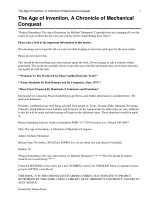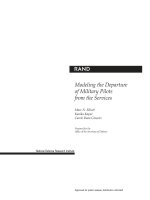Public utilities in the age of partnership lessons from private participation in urban water supply
Bạn đang xem bản rút gọn của tài liệu. Xem và tải ngay bản đầy đủ của tài liệu tại đây (3.38 MB, 436 trang )
PUBLIC UTILITIES
IN THE AGE OF PARTNERSHIP:
LESSONS FROM PRIVATE PARTICIPATION
IN URBAN WATER SUPPLY
R. SCHUYLER HOUSE
NATIONAL UNIVERSITY OF SINGAPORE
2014
PUBLIC UTILITIES
IN THE AGE OF PARTNERSHIP:
LESSONS FROM PRIVATE PARTICIPATION
IN URBAN WATER SUPPLY
R. SCHUYLER HOUSE
(MIM, University of Maryland, University College)
A THESIS SUBMITTED FOR THE DEGREE OF
PHD, PUBLIC POLICY
LEE KUAN YEW SCHOOL OF PUBLIC POLICY
NATIONAL UNIVERSITY OF SINGAPORE
2014
i
Declaration
I hereby declare that this thesis is my original work, and it has been
written by me in its entirety. I have duly acknowledged all the sources
of information that have been used in the thesis.
This thesis has also not been submitted for any degree in any
university previously.
R. Schuyler House
18 Oct 2014
ii
iii
Acknowledgements
This thesis represents a long journey from the measurable, tidy world
of engineering to the political-economic world in its fascinating
messiness. It is the product of three years of work, which I cannot
altogether claim to be mine: indeed, I have many supporters to thank.
One person, however, stands out in his support and commitment to
seeing me through. My advisor, Professor Wu Xun, has given me sage
guidance and a special brand of clear-headed, logical, and helpful
critique. He has been generous with time and attention and has pushed
me to seek high standards while affording me the flexibility I needed as
a working mother. I am enormously thankful, and I believe he has set a
great example as a progressive and consummate professional.
I thank also the Institute of Water Policy and the Lee Kuan Yew School
faculty for sharing valuable support, knowledge, and research advice. I
particularly thank Ed Araral and Mike Howlett for their comments and
vital support. Other faculty members with whom I studied and worked
most closely, including Scott Fritzen, Caroline Brassard, Darryl Jarvis,
Toby Carroll, Ann Florini, and Mukul Asher, introduced me to different
aspects of policy studies and research, contributing distinct and
important methodological, philosophical, and practical guidance.
My colleagues in the doctoral program have been supportive, thought-
provoking, and always interesting. I am honored to have been a part of
this diverse, capable, and intelligent group. I wish them all the very best
iv
in their professional endeavors and life adventures, and I am thankful
for the special bond we developed through shared experience.
Finally, I would like to acknowledge family and friends. Several friends
consistently encouraged my decision to enter and stick to the program:
Tamara Lynch, Caitlin Fry, Jenny O’Malley, Stowe Alrutz, Anne
Duncan, Annette Foster, Johanna Barry, Maureen Birdsell, and Sarah
Cockerill, amongst others. Thanks for sticking by when I forgot coffee,
failed to respond to email, and drifted in and out of reclusion.
I also have an enormously loyal, beautiful family to recognize. Thank
you to my husband, Stewart, for his willingness to listen to ideas and
unwillingness to hear grumblings of defeat, forgiveness when stress did
the talking, and reliable wine ministration. Thank you to my father, Dan
Houser, for setting the bar high, to Avery, for comic relief, and to my
mother, Page, for believing fully – and for telling me I could quit if it got
to be too much. By saying so, you let the choice be 100% mine. I also
thank Chickadee for modeling boldness, and my helper, Precila Mejia,
who has been a second mother to my children.
Finally, I salute my three astonishing, brave, clever daughters: Flynn,
Paige, and Libby – all wee people of great resilience, patience, and
humor. You will always be my greatest project and proudest triumph. I
cannot wait to see what amazements the world reveals to you and what
treasures you offer in return.
v
Table of Contents
Declaration i!
Acknowledgements iii!
Table of Contents v!
Summary ix!
List of Tables, Figures, and Abbreviations xiii!
Tables xiii!
Figures xv!
Abbreviations xvi!
Chapter 1. Public services and the partnership paradigm 1!
1.1 Dimensions of success and failure 5!
1.2 Research questions 8!
1.3 Research focus: Success and failure in PPP 11!
1.3.1 The unit of analysis: The urban water utility PPP 13!
Chapter 2. Literature review: Failure and partnership 21!
2.1 Market failure, government failure, and something else? 22!
2.2 Water is special 29!
2.3 Models of water provision 32!
2.3.1 Water PPP forms 35!
2.4 Contested logics of water partnership 38!
2.5 Theory on institutions and dynamic inconsistency 42!
2.5.1 Dynamic inconsistency and the “selves” of partnership: Another
way to skin the cat 48!
2.5.2 Nestedness and plurality in commitment 51!
2.5.3 The multiple commitment problem 56!
2.6 Sustainability and PPP in urban water supply 60!
2.6.1 Project governance and participants 62!
2.6.2 Operating context 68!
2.6.3 Regulatory structure and environment 71!
2.6.4 Institutional endowments and meta-level political conditions 76!
2.7 Analytical framework and research overview 79!
Chapter 3. Patterns in PPP survival: Statistical evidence 90!
3.1 Quantitative methodology 93!
3.1.1 Quantitative data 94!
3.1.2 Quantitative models 102!
3.2 Describing PPP experiences: Emerging patterns 104!
3.2.1 Difference in means of failure rates 115!
vi
3.3 Modeling early termination and survival 118!
3.3.1 Data limitations 119!
3.4 Testing institutional and ideational environment 124!
3.4.1 Sigma models 125!
3.4.2 Kappa models 128!
3.4.3 Iota models 144!
3.5 Driving qualitative research 145!
Chapter 4. Pathways to survival: Three Southeast Asian cities 150!
4.1 Framing for comparison: Qualitative methodology 151!
4.2 Informing the PPP comparative framework 152!
4.2.1 Case overview and selection 160!
Chapter 5. Jakarta: Rigidity and regulatory relegation 166!
5.1 Suharto’s legacy 172!
5.2 The contracts: Ambiguity, imposition, and deferment 174!
5.3 Early shock: The Asian Financial Crisis 180!
5.3.1 Partial recovery from the flashpoint 183!
5.4 Slow burn: Rate rebasing and slide into deadlock 188!
5.4.1 Thames’ Retreat and Localization of the East 193!
5.5 Foreign retreat 196!
5.6 Mixed performance outcomes 210!
5.7 Problems: Regulation, contract design, information, and culture 217!
5.8 Adaptation and inflexibility 229!
Chapter 6. Manila: Adaptive regulation and balancing inconsistency . 232!
6.1 Manila concessions and the Philippine political economy 234!
6.1.1 Ushering in PSP 236!
6.2 Concession bidding and selection 239!
6.2.1 Next-Best Regulation 243!
6.3 Early problems and the test of regulator legitimacy 245!
6.3.1 Rebasing and learning 249!
6.4 Remunicipalization and rebid 252!
6.4.1 MWSS-RO limits exposed 256!
6.5 Instrumental and (tentative) institutional success 257!
6.5.1 Manila’s maturing water market 264!
6.6 Dynamic inconsistencies (good and bad) and regulatory adaptation . 268!
6.6.1 Evolving regulation: legitimacy, enforcement, and discretion 271!
6.6.2 Operator competence, culture, and legitimacy 277!
Chapter 7. Selangor: Information and power in PPP 282!
7.1 Political background to the Selangor deals 283!
7.2 Malaysia’s industrial and water policies: Application to Selangor 286!
7.3 Overlapping mandates and authority 293!
vii
7.4 Four deals and innumerable spin-offs 298!
7.4.1 Sungai Selangor Water Supply Scheme 300!
7.4.2 Increasing demand and company profitability: Deal drivers in the
early 2000s 304!
7.4.3 SYABAS: Privatizing distribution 309!
7.4.4 Things fall apart: 2008 election upset and the churning of the
system 313!
7.5 Contesting PSP: Fighting in the dark 314!
7.5.1 Bailouts, lawsuits, and “manufactured” crises 317!
7.6 The limited reach of regulation 325!
Chapter 8. Adaptation and commitment: Analyzing PPP failure 334!
8.1 Synthesizing major findings 336!
8.1.1 Participants: Foreign participation, ownership, and bureaucratic
quality 338!
8.1.2 Rooted conditions: The institutional environment 343!
8.1.3 Strategies, outputs, and decisions 346!
8.1.4 Context dynamics 349!
8.1.5 Project rules: Sticky policy choices 352!
8.2 Credibility and adjustment: Interests, rules, and information 356!
8.2.1 Motivational credibility: Interests and alignment 358!
8.2.2 Imperative credibility: design, regulation, and oversight 361!
8.2.3 Adjustment and learning in PPP sustainability 366!
8.3 Configurative effects on performance 370!
8.4 Research contributions: Practice and theory 379!
8.5 Concluding remarks 389!
Bibliography 392!
Appendix 1. List of interviews 409!
Appendix 2. Institutional environment variables 410!
Appendix 3. Central tendencies of cancellation and distress 412!
Appendix 4. Comparative failure rate central tendencies 413!
Appendix 5. Multicollinearity testing: Correlation tables 414!
viii
ix
Summary
This thesis reflects on the application of public-private partnership to
urban water supply in developing countries. While PPPs remain an
interesting possibility for overcoming financial, quality, and efficiency
issues common to public provision in developing region municipalities,
this research demonstrates that management of long-term contracts
requires technically complex administrative and regulatory inputs,
particular institutional underpinnings, and fitting modes of adaptation in
order to attain the goals that motivate private participation. The
research problematizes the notion of “success” in PPP by proposing
that institutional performance (lastingness) and instrumental
performance (attainment of policy goals) are not one and the same,
and that instrumental failure coupled with institutional success may be
a far worse policy outcome than systemic failure along both
dimensions.
The research applies an innovative PPP framework for examining the
conditions of institutional and instrumental performance based on
notions of credible commitment and adaptability. Quantitative and
qualitative analyses, in tandem, examine the effects of four variable
classes: rooted conditions, context dynamics, regulatory settings, and
project rules and participant capacities. These variable classes, in turn,
are linked to the credibility of commitments and capacity for the PPP to
adjust to external shocks, new information, and changing operating
x
contexts over time. In order to do so, the research employs a multiple
methods approach incorporating large-N quantitative regression
analyses and comparative case studies of water supply concessions in
Jakarta, Indonesia; Manila, Philippines; and Kuala Lumpur, Malaysia.
The quantitative research draws on a number of data sources that
provide information on the project rules and rooted conditions. These
data sources include The World Bank’s Public-Private Infrastructure
Advisory Facility’s project database, The World Bank Governance
Indicators, Transparency International, and the Database of Political
Institutions. A series of logistic multinomial regressions are employed to
test links between the institutional environment and project rules and
contract durability. The analysis suggests that corruption and low
bureaucratic capacity, counter-intuitively, tend to have sustaining
effects on PPPs, and that the participation of multilaterals is also
supportive of contract sustenance. Economic shock and the
participation of foreign partners, on the other hand, tend to be
detrimental.
The qualitative case comparisons that follow further investigate the
dynamics of the variable classes on institutional and instrumental
performance. The cases also grapple with the surprising results of the
quantitative analysis and examine major variables less amenable to
quantitative analysis. The case comparisons demonstrate that
institutional settings can have different effects at different phases of a
PPPs lifecycle and in combination with other contextual factors and
xi
also show that PPP cancellation and survival are not necessarily good
indicators of success. The cases reveal how inter-governmental
conflict, bureaucratic torpor, and political volatility can have sustaining
effects on low-performing PPPs: i.e., they can prevent cancellations
that may be preferable. The cases also demonstrate the central role of
strong, well-informed, and responsive regulation as well as the capacity
and legitimacy problems that easily interfere with the assurance of
credible commitment. Further, the qualitative analysis demonstrates the
delicate and tenuous balance between adaptability needed in
developing region contexts and modes of enforcing commitment in
long-term agreements.
xii
xiii
List of Tables, Figures, and Abbreviations
Tables
Table 1. Dimensions of PPP performance 7!
Table 2. Governing Nature: Three Models 32!
Table 3. Water PPP arrangements 37!
Table 4. Allocation of key responsibilities for PPP options 37!
Table 5. Water supply PPPs in summary 38!
Table 6. Summary, variable classes 83!
Table 7. Research cases 86!
Table 8. Project characteristic variables 95!
Table 9. Project structure variables 96!
Table 10. Project actor variables 96!
Table 11. Project outcomes variables 96!
Table 12. Institutional environment variables, summary 97!
Table 13. Idea variables 99!
Table 14. Duration to Project Cancellation 103!
Table 15. PPP projects by type and status 109!
Table 16. Projects cancelled or distressed by type 110!
Table 17. Projects cancelled or distressed by region 111!
Table 18. Investment commitments and failed project commitments by
region 113!
Table 19. Investments and failed project commitments by type 113!
Table 20. Cancelled or distressed utilities by type and region 114!
Table 21. Percentage of utilities cancelled (of total utilities of type) 115!
Table 22. Difference in means of failure rates: Structure and
membership 116!
Table 23. High variable correlations 123!
Table 24. Independent variable regressions with multicollinearity 124!
Table 25. Sigma models of survival and cancellation 126!
xiv
Table 26. Kappa models, institutions and participation, 5-year survival
139!
Table 27. Kappa models, institutions and participation, 10-year
survival, all projects 140!
Table 28. Kappa models, institutions and participation, 10-year
survival, concessions only 141!
Table 29. Kappa models, institutions and participation, cancellation, all
projects 142!
Table 30. Kappa models, institutions and participation, cancellation,
concessions only 143!
Table 31. Iota models, Ideas 144!
Table 32. Comparative variable classes 160!
Table 33. Case studies 163!
Table 34. Jakarta service expansion targets and performance 216!
Table 35. Manila Concession Bid Submissions 240!
Table 36. Maynilad KPIs, 2007-2011 263!
Table 37. Concession cancellation / distress rate comparison by
participant 340!
Table 38. Configurative effects of variable class on performance 372!
xv
Figures
Figure 1. Concessions relationships 66!
Figure 2. Mapping institutional and instrumental performance 87!
Figure 3. Linking analytical components 88!
Figure 4. Water PPP projects by type 105!
Figure 5. Projects by region and project type 105!
Figure 6. Annual project closures by region 106!
Figure 7. Annual project closures by region, China 106!
Figure 8. Annual water PPP investments by region 108!
Figure 9. PPP projects by type and status 110!
Figure 10. Project cancellations by year and region 112!
Figure 11. Manila Water Company performance, 1997-2013 259!
Figure 12. Maynilad Water Services performance, 1997-2013 259!
Figure 13. Manila water tariff rates, 1997-2013 262!
Figure 14. Manila water supply coverage targets and actual
performance 264!
Figure 15. Relationships between framework components 378!
xvi
Abbreviations
ABASS Konsortium Aliran Bekalan Air Selangor Selatan
ADB Asian Development Bank
BN Barisan Nasional
CA Cooperation Agreement
Capex Capital expenditure
CPI Consumer Price Index
DKI Daerah Khusus Ibukota (Special Capital District)
DPRD Dewan perwakilan rakyat daerah (council)
FCDA Foreign Currency Differential Adjustment
IFC International Finance Corporation
JWSRB Jakarta Water Supply Regulatory Body
KL Kuala Lumpur
KPA Kekar Pola Airindo
LTIC Long-term infrastructure contract
MWSS Metropolitan Waterworks and Sewerage System
MWSS-RO Metropolitan Waterworks and Sewerage System
Regulatory Office
OCP Opening Cash Position
Opex Operating expenditure
PAAB Pungurusan Aset Air Bahad
Palyja PAM Lyonnaise Jaya
PAM Jaya Perusahaan Daerah Pelayanan Air Minum Jakarta Raya
PDAM Perusahaan Daerah Air Minum
PFI Private Finance Initiative
PJTII Perum Jasa Tirta II
PPI Private Participation in Infrastructure
xvii
PPIAF Private Participation in Infrastructure Advisory Facility
PPP Public private partnership
PR Pakatan Rakyat
PSP Private sector participation
RB Regulatory Board
RCA Restated Cooperation Agreement
RO Regulatory Office
SPAN Suruhanjaya Perkhidmatan Air Negara (National Water
Services Commission, Malaysia)
SPLASH Syarikat Pengeluar Air Sungai Selangor
SYABAS Syarikat Bekalan Air Selangor Sdn. Bhd.
TPJ Thames Pam Jaya
UMNO United Malays National Organization
WRC Water Regulatory Commission
1
Chapter 1. Public services and the partnership paradigm
The partnership paradigm has undoubtedly made an indelible and
sustained mark in public service literature and practice. Evolving and
highly variant partnership forms involving governments, multilateral
institutions, civil society organizations, and businesses in multitudinous
architectures have come to serve social aims across sectors, including
infrastructure, public health, education, enterprise development, and
public utilities. Despite concerns about the effectiveness and efficiency
gains used to justify private provision of traditionally government-
provided goods, alongside important concerns about democratic
accountability, partnerships have become an important new institutional
form in the implementation of policies of all types.
Experimentation with public-private partnerships [PPP] in different
forms is a response to perceived and / or real market and government
failures, for which different service forms have been alternatively
adopted over time. The selection of a particular delivery form –
government, market, or hybrid – for a public service is dependent not
only on the policy problem at hand, but also on past decisions and
prevailing ideas, as well as available managerial, political, and physical
resources and knowledge. Partnerships, and more specifically PPPs,
are employed to address policy problems characterized by
amalgamations of government and market failures. As such, they join
2
public and private sector actors in partnership to overcome inherent
weaknesses and take advantage of inherent strengths of each.
This thesis reflects on the application of PPP to a politically and
materially complex good, urban water supply, in order to examine the
institutional and political difficulties associated with contract-based
partnerships, especially in developing regions. Traditionally,
governments have been tasked with providing water services due to
market failures associated with monopoly, externalities, high sunk costs
and free-rider problems, as well as to preserve access to this life-
essential resource. Over the past twenty-five years, however, in
response to perceived government failures including operational
inefficiencies, rent-seeking, and over-subsidization, market
mechanisms have been employed along a spectrum of corporatization
to partnership to privatization, what Menard and Peeroo more loosely
refer to as forms of “water liberalization” (Menard & Peeroo, 2011). In
some cases post-privatization, the balance of multiple failures has
tipped towards the market, leading to the abandonment of PPP and re-
municipalization. In fact, the past five years of scholarship and public
commentary related to PPPs, particularly in water services, has tended
to portray private participation in water supply as a failed experiment
(Araral, 2009; K. J. Bakker, 2010; D. Hall & Lobina, 2006; Hukka &
Katko, 2003; E. Lobina, 2005), despite its continued application.
Nevertheless, while literature and commentary decrying the failure of
3
PPP is pervasive, the number of partnership contracts across sectors
has grown over the past few years, albeit at decreasing rates.
So, while hope for the promises of partnership keeps the movement
buoyant, the problem of how to theoretically account for and practically
manage the implications of market, government, and combined market-
government failures remains unresolved. This begs the need for an
expanded idea of institutional or governance failure in the provision of
complex goods with both public and private characteristics.
Additionally, the practical issue of supplying water in urban developing
regions remains enormously challenging. Certainly, we have yet to
definitively answer the questions: do PPPs, particularly in water supply,
work? And if so, how, where and under what conditions?
Evidence has been accumulating to explain the emergence and
outcomes of partnership programs, but there is much yet to be learned
about the combinations of factors necessary to designing and
maintaining partnerships that last, accomplish their stated aims, and
deal with the failures that motivated their employment. While more
“transformational,” trust-based forms of open, participatory,
collaborative policy-making and implementation are de rigueur in policy
discourse, the mechanics and politics of more traditional “transactional”
contracts-based public-private partnerships remain relevant. The focus
of this research is on the application of the PPP or private sector
participation [PSP] model to water supply and the issues that arise
when this institutional form is applied to a good whose delivery is









